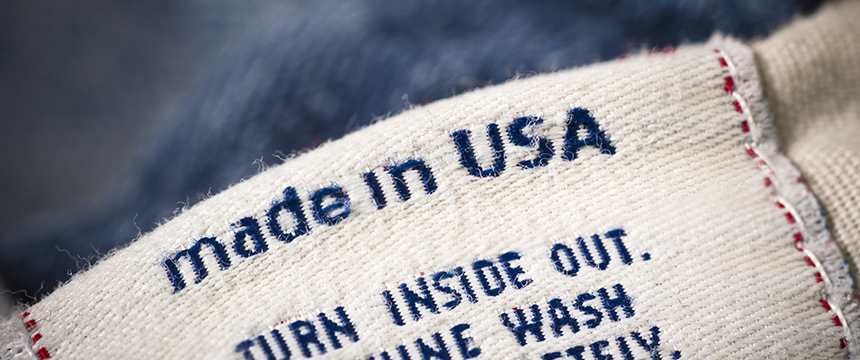What Every Multinational Company Should Know About …“Made in USA” Labeling Requirements

Many Americans value domestically made goods. A “Made in USA” label can hold special meaning for these consumers, as it serves as a symbol of patriotism, a sign of quality craftsmanship, and a show of solidarity with local industries, among other things. Recognizing this, U.S. companies often look for opportunities to market their products with statements like “Made in USA,” “Made with Pride in America,” “American Craftsmanship,” or to use an American flag or even American addresses to communicate the U.S. origin of goods.
But behind the “Made in USA” label lies a complex set of regulations designed to ensure that such statements are truthful, accurate, and not misleading to the average consumer. These marketing regulations are enforced at multiple levels, including at the federal level by the Federal Trade Commission (FTC), by states (notably, California and New York), and even by big-box retailers.
In a period of increasing enforcement of these requirements, this article provides guidance about navigating these marketing regulations. It also distinguishes labeling regulations from several other “USA”-related requirements, such as country-of-origin marking requirements overseen by U.S. Customs & Border Protection (CBP) and “Buy American” standards, that are often conflated with “Made in USA” marketing statements.
“Made in USA” Marketing Statements
At the outset, the decision to attach a “Made in USA” label to a product is a discretionary one; there is no requirement to label a product sold within the United States as “Made in America” or “Made in USA.” If a company decides to use such labeling, then the claim must comply with certain regulations. These rules apply regardless of where the claim appears — i.e., on the product’s label, in marketing materials, or on the internet. At the heart of “Made in USA” labeling requirements is the FTC’s “all or virtually all standard.”
Unqualified Claims – FTC’s “All or Virtually All” Standard
The FTC is authorized to regulate claims of U.S. origin pursuant to the Made in USA Labeling Rule (16 CFR § 323). Under this rule, the term “Made in the United States” means any unqualified representation, whether expressly stated or implied, that a product or service is of U.S. origin. This includes, but is not limited to, representations that the product or service is “made,” “manufactured,” “built,” “produced,” “created,” or “crafted” in the United States of America, and any other unqualified statement suggesting U.S. origin. The FTC rule can also apply to the use of imagery, such as a U.S. flag or map to imply U.S. origin. Penalties for violating these regulations can be stiff. Noting the increased use of “Made in USA” in advertising claims, the FTC recently introduced a broader range of remedies, including civil penalties of up to $51,744 per violation. Settlements with FTC in “Made in USA” actions have reached seven figures.
The FTC does not offer a safe-harbor procedure for “pre-approving” claims of U.S. origin. Instead, it evaluates “Made in USA” claims made by companies in retrospect using a three-part test:
- Does the final assembly or processing of the product occur in the United States?
- Does all significant processing that goes into the product occur in the United States?
- Are all or virtually all ingredients or components of the product made and sourced in the United States?
Unqualified “Made in USA” claims can be made only if a company has a “reasonable basis” — meaning competent and reliable evidence based on reasonable due diligence — that a product contains no, or only a negligible amount of, foreign content. There is not a bright-line test for “all or virtually all,” but the FTC will consider the proportion of U.S. manufacturing costs (based on the cost of goods sold) as well as (i) the total cost of all manufacturing materials, (ii) direct manufacturing labor, (iii) manufacturing overhead, and (iv) remoteness of foreign content.
In short, before making any unqualified claim that a product is “Made in USA,” companies should conduct due diligence on the product’s components and manufacturing costs to ensure that the product satisfies the “all or virtually all” standard. This means confirming that the product contains no (or negligible) foreign content and compiling competent and reliable evidence to back up that claim if ever questioned.
Qualified U.S. Origin Claims
While unqualified “Made in America” claims are subject to stringent requirements, companies have more flexibility with respect to making qualified U.S.-origin claims. A qualifier means that there is a claim of U.S. production but that it does not apply to the entire production process or the entire good. Qualified claims — such as “Made in USA of U.S. and imported parts” or a claim that only a specific part of the product is made in the United States — are permissible, provided they are accurate and not misleading. Using the previous example, stating a product is “Made in USA of U.S. and imported parts” may be deemed misleading or inaccurate if only a minority of the content or processing comes from or is performed in the United States. As such, qualified claims that describe the extent, amount, or type of a product’s domestic content or processing (e.g., “Made in USA of 80% U.S. parts and 20% foreign parts”), or otherwise add context when a product is not “all or virtually all” U.S. made, are preferable and mitigate the risk of misleading consumers. Qualified and specific statements also minimize the chances of a company being the target of class action plaintiffs who target the makers of unqualified Made in the USA claims.
Again, because the FTC does not pre-approve U.S. origin claims, companies cannot avail themselves of a “safe harbor” pre-approval. The FTC recognizes this dilemma and publishes guidance — with numerous proper and improper examples of both unqualified and qualified U.S.-origin claims — to help the business community create effective and legal advertising statements. See https://www.ftc.gov/business-guidance/resources/complying-made-usa-standard. Companies are well-served by reviewing this guidance and developing data backed, specific, and qualified statements that highlight a product’s U.S. inputs…
Finally, it is worth noting that “Made in USA” labels are advertising and thus subject to FTC advertising regulations. Section 5 of the FTC ACT (15 U.S.C. § 45) prohibits “unfair or deceptive acts or practices in or affecting commerce.” Thus, any claims must be truthful and substantiated, meaning that any qualified claim of U.S. origin must be clear, prominent, proximate, and not contradicted by other claims. Consistent typeface, size, and color should be used for the entirety of the claim.
State Regulations
In addition to federal regulation by the FTC, many states have truth-in-advertising laws that govern false claims, including improper usage of “Made in the USA.” Many of these laws allow consumers to sue, incentivizing plaintiffs to bring class action lawsuits and seek settlements. While most states have laws that mirror the FTC’s standard, some states have enacted additional, heightened standards, including laws that allow private persons who claimed they were misled by any false claims to bring private lawsuits. For companies that sell products across the United States, these state laws must be considered too.
California is one such state that actively enforces its truth-in-advertising regulations relating to unqualified “Made in USA” claims (Cal. Bus. & Prof. Code §17533.7). In the past, California law essentially required 100 percent of a product’s content to be domestically sourced in the U.S. In 2016, however, California relaxed this standard and put in place a bright-line test. The revised standard now permits products sold in California to be marked as “Made in USA” or “Made in America” if only a small part of the product’s contents is of foreign origin. Specifically, so as long as the foreign materials or parts do not exceed five percent of the final wholesale value of the merchandise, then a “Made in USA” claim can be made. Or, if the manufacturer of the merchandise can show that it cannot obtain certain materials or parts in the United States, then the total foreign content cannot exceed 10 percent of the final wholesale value of the item.
As noted above, the FTC’s “all or virtually” standard does not establish a specific amount of foreign content that would be deemed acceptable for making unqualified claims. In practice, many companies selling nationally use California’s five-percent rule as their rule of thumb for making unqualified U.S. origin claims (particularly given California’s sizeable role in the U.S. market). Although the FTC does not have an established bright-line rule, in most cases a product that boasts 95 percent or more U.S. production and value will meet the all-or-virtually-all FTC rule.
Retailer Requirements
Finally, some large resellers have established their own, more exacting standards and procedures, which companies should also consider depending on how they market their products. These commercial requirements are a reaction to the addition of resellers to “Made in USA” lawsuits against their suppliers. In most cases, the large retailers have adopted the most stringent rules enforced by states, because they want to maintain a nationwide inventory. In practice, this means that some of these retailers continue to apply the old California rule, thus requiring basically 100-percent U.S.-origin content to support any unqualified Made in the USA claim. Depending on how companies intend to distribute their products, companies also should be mindful of these retailer standards as they are developing appropriate statements on the U.S. origin of their products.
Distinguishing Other “U.S.”-related Requirements
This article focuses on the use of “Made in USA” in making advertising and labeling claims, which, as described above, are regulated by the FTC, state truth-in-advertising laws, and “private” requirements put in place by big-box resellers. Other areas of law, however, also take U.S.-origin of products into consideration. Two areas that oftentimes get confused with “Made in USA” advertising requirements are country-of-origin marking requirements regulated by U.S. Customs & Border Protection (CBP) and the Buy American Act.
Under CBP regulations, every article of foreign origin imported into the U.S. must be marked with its country of origin pursuant to 19 U.S.C. §1304. The country-of-origin marking generally needs to be on the good itself (or in a form that is not likely to fall off or be obscured), and this marking must reach the “ultimate purchaser” — the last person in the U.S. who will receive the article in the form it was imported. We address CBP marking requirements more fully in an upcoming article, but for purposes of this article on “Made in USA” advertising, note that any U.S.-origin advertising claims cannot conflict with CBP marking requirements. Simply stated, a product marked as “Made in Japan” should not be advertised with an unqualified “Made in USA” claim.
Buy America Act requirements are also sometimes confused with “Made in USA” advertising regulations. Buy American requirements relate to direct purchases by the U.S. federal government valued at more than US$10,000. More specifically, Buy America requirements apply to purchases of iron, steel, and other manufactured products permanently incorporated into infrastructure projects, and these projects must be undertaken by U.S. states and municipalities with funds issued by certain U.S. federal departments and agencies.
Some Practical Advice Regarding Made in USA Claims
Many companies pay little attention to the potential risk from their Made in USA claims. This risk, once remote, is ever present and increasing as technology improves the ability for plaintiffs to efficiently search the internet for unqualified claims and potential class action defendants. Further, the FTC has been increasingly aggressive in enforcement, putting in place some major settlements against some well-known retailers. In light of these realities, we offer a few practical things that companies can do to minimize their chances of Made in USA labeling and advertising claims issues:
- Review all master agreements with retailers and distributors to determine if they impose special Made in USA labeling requirements.
- Gather all product labels to determine which ones make unqualified claims and determine if those products have been analyzed for adequate support.
- Have your IT department pull any products that make Made in USA claims, to determine if they are consistent with labeling requirements.
- Review any labels to see if they include indirect references to Made in USA status, such as American flags or U.S. addresses, to see if they comply.
- Review third-party sales sites to see if there are Made in USA claims that go farther than the product can support.
If you have questions or concerns about this article, please feel free to reach out to any of the authors or your Foley & Lardner attorney. If you would like to see future updates regarding “What Every Multinational Company Needs to Know” about operating in today’s complicated international trade world, please sign up for our biweekly email list. Click here to register.
To view all articles in our “What Every Multinational Company Needs to Know” series, click here.


